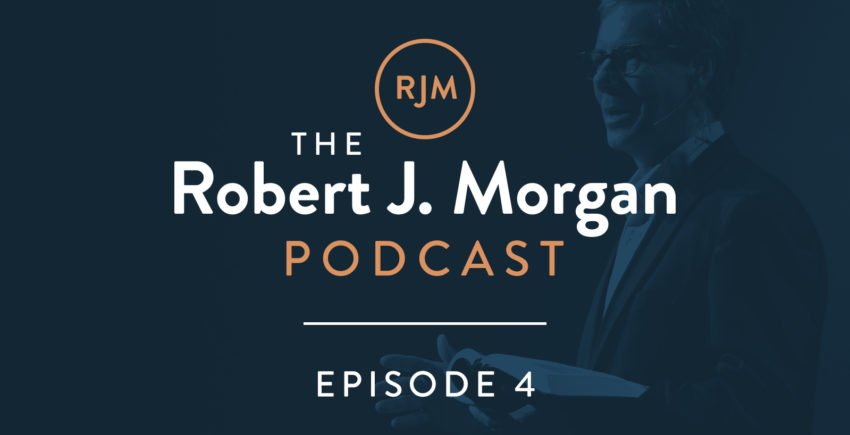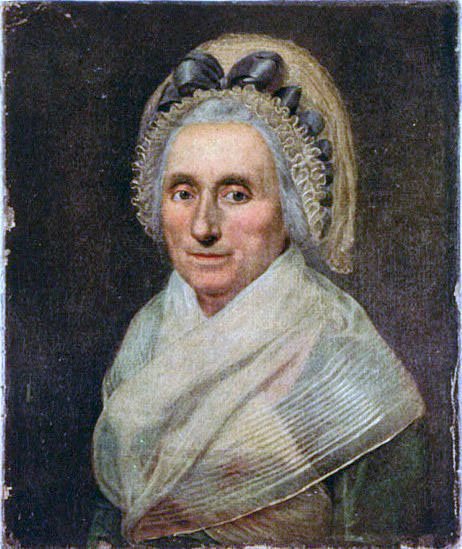
This article is based on the Robert J. Morgan podcast and has been partially edited for readability.
I want to introduce you to a fascinating woman whose simple life has sent historians into fits. Her name is Mary Bell Washington, and she became the mother of America’s first President. After her life, she had a rather complicated relationship with her son, George. After her death, she was admired as a hero and a woman who overcame tremendous obstacles to raise the nation’s Founding Father. In recent years, historians have decided she was a rather despicable woman and she is often presented in negative—and rather unfair—terms. After all, she did raise one of the greatest men of the ages.
Martha Saxton opens her recent biography of Mary with these words: Mary Ball Washington was orphaned early, grew up poor, and was later widowed with five children under the age of twelve to support. She did the best she knew for her family in the harsh world of the eighteenth-century Chesapeake. She poured her exceptional vitality, deep religious convictions, and unflagging persistence into her first son, George. We still admire him for the honorable way he used those qualities to create a country and a government. Why has she not received historians’ respect for her years of lonely and challenging work?”
Early Beginnings
Mary was born in the early 1700s in the Tidewater area of Virginia, and from the beginning, she suffered tremendous losses. Her father died when she was an infant, and her mother died when she was twelve. She was taken in by her half-sister, but she largely had to raise herself.
Mary didn’t have much emotional support as a teenager, but she did embrace the Anglican faith and learn the catechism. She begins to lean on the Lord for support.
Mary also became a skilled horse-rider and an expert dancer.
At the age of 22, she married Augustine Washington. She was described as “a strong, healthy young woman with light-colored hair, clear blue eyes, and a pleasant voice.” The couple made their home to the east of Fredericksburg, Virginia. Their firstborn son, George, was born on February 22, 1732. They moved closer to Fredericksburg and the couple had five more children, one of whom died in infancy. Augustine also died, and Mary was left a young widow to raise her children alone.
Now, there’s one thing we cannot gloss over. From the time she was three years old until her death, Mary owned slaves. So did George, of course, and Thomas Jefferson, and many of the other Founding Fathers who lived in the Mid-American states. It is frankly hard for me to understand how people—especially Christians—did not see the evil, the horror, the brutality, and the inhumanity of that. I can only understand it by comparing the similar blindness today’s society has toward the evils of abortion. Future generations will look back with horror at this, the way we look back with horror on slavery. Nothing excuses the degrading and discarding of human life, either through bondage or abortion.
But Mary was a product of her times with a worldview that was blind to the inhumanity of slavery. I don’t understand it. I don’t like it. But it was part of the social fabric of the time.
And yet she was a tough and resilient woman who, as a single mother, raised five children. She was strong-willed. In 1746, George wanted to join the British Royal Navy, but Mary, who had already lost her mother, father, husband, and child, was horrified at the prospect. At her insistence, he gave up his plan. George later said that his mother so beseeched him that he had to retrieve his packed bags from aboard ship and give up his plans.
Historians have criticized Mary this, but how many mothers would allow their fourteen-year-old son to go off and join the British Navy? It couldn’t have been easy to be George Washington’s mother. He ended up engaged in death-defying military missions during the French and Indian War, and as his popularity grew, so did Mary’s anxiety.
The Christian Life
In 1771, Mary moved into a house George purchased for her in Fredericksburg. It was near her daughter, Betty, with whom she was exceedingly close. She had a beautiful garden, which is kept in her memory to this day. The house, which is open today to the public, sits on a corner lot with two parlors in the front and a dining room in the back that looked out onto the garden. Behind the garden was an orchard.
Nearby was a formation of rocks, and this is where Mary loved to go for private prayer. She loved her Bible and she constantly read a handful of rich and personal devotional books. When I use the phrase “devotional books,” don’t picture a short little book with nice devotional thoughts. These were virtual textbooks, each hundreds of pages long, printed in small type.
One was entitled The Christian Life, From Its Beginnings to Its Consummation in Glory by the English devotional writer, John Scott. The extant copy of this book in her library shows her name written in it in 1728 when she would have nineteen or twenty. Here is a sample from this book:
As for the end of the Christian life, we are assured from Scripture that it is no other but heaven itself, the state of endless bliss and happiness, which God has prepared in the world above for all those who, by patient continuance in well-doing, seek for glory and honor and immortality. That this is the end of the Christian life is evident from hence, because it is everywhere proposed by our Savior and the Apostles as the Chief Good of the Christian and the supreme motive to all Christian virtue. For so St. John, that bosom-favorite of our Savior, assures us, this is the promise which Christ has promised us, even eternal life…. He that believes has life everlasting.
Pilgrims Upon Earth
He went on to say:
Now we are no longer to look upon this world as our native country but as a foreign land; and so we are to reckon ourselves strangers and pilgrims upon earth…”
He said, “It may be your lot to take up the cross and follow your Savior through a dark lane of suffering, and then you will need a world of patience and courage.”
He wrote, “The holiest service that we do is an honest calling, though it be but to plow or dig, if done in obedience and conscience of God’s command.”
Scott suggested having devotional times of prayer and biblical reflection both morning and evening, and one family remember recalled how Mary, even in her later years, worked hard to maintain her private times with the Lord.

Contemplations Moral and Divine
Her favorite devotional book was Contemplations Moral and Divine, by Matthew Hale. Her husband gave it to her, and she signed her name in it after her marriage. Hale acknowledges that life is full of trouble, that our great consolation is heaven, and that we should learn to remain cheerful even amid the burdens of life.
Let me just give you a sentence out of this massive work: “As thus the knowledge of Christ Jesus and him crucified excels all other knowledge, and so in comparison thereof, all other knowledge, upon a right judgment, is as nothing, so the soul, being rightly convinced thereof, sets a higher price upon that knowledge than upon all other knowledge besides.”
The Bible and these devotional books were her library, and with these, she raised her children and taught her grandchildren. Matthew Hale’s book, Contemplations Moral and Divine was the primary text she used in raising her firstborn son, and he was prone to quote some of the lessons throughout the rest of his life.
When George later became the Commander in Chief of the American Revolutionary Army, she must have been proud of him, but she worried constantly about his safety. She saw little of him during the Revolution. At one point, the war drew dangerously close, and, since it would have been unthinkable for the mother of George Washington to be captured by the British, she had to flee with her family to the mountains. She was unwell, elderly, and she had to live in very difficult conditions—and she hadn’t see her son for years.
But Mary was always worried about having enough money to support her rather simple lifestyle, and George became exasperated with her requests for funds. He finally wrote her a little that seems to me to be unfortunate, insensitive, and downright rude. He told her she should move in with one of her children.
The Last Days of Mary Washington
Mary was also a plain woman, with little education. She lacked the social skills that Washington had acquired. He was hesitant to have her at Mount Vernon because he was afraid she’d been out of place.
She battled anxiety all her life. For example, from childhood, she had been deathly afraid of thunderstorms. Even during her last years, they produced acute anxiety. Once in old age, she was spending time in her daughter, Betty’s, house, and a thunderstorm blew in. Suddenly Betty realized her mother was missing. Betty found her upstairs kneeling in prayer. Getting up, she confessed that she had been “striving for years against this weakness, for you know, Betty, my trust is in God, but sometimes my fears are stronger than my faith.”
However, she lived just long enough to learn that her son had been chosen as the first President of the United States. He traveled to visit her, knowing she was ill. He received her blessing as he traveled on to New York City for the Inauguration.
Her last days were more peaceful. Her biographer wrote, “Mary resumed gardening and reading and sometimes recreated the meditative state she achieved in thinking about God’s ways and his will, reciting a well-known passage from (her devotional books) and reading her family Bible to the grandchildren. She continued to visit her beloved large flat rocks, surrounded by trees, where, according to her step-grandson and others, she communed with her Creator in humiliation and prayer. One grandson…remembered her teaching lessons about natural history, finding illustrations in their surroundings. She would tie the natural world around them to the Bible story of creation…. Much later one grandchild spoke for the others when he said, “There was a spell over them as they looked into their grandmother’s uplifted face, with its sweet expression of perfect peace.”
She loved tea, and trained all her children to serve and drink tea in the afternoon. A pastime she also enjoyed with her grandchildren.
Leaving a Legacy
In 1789, Mary was found to be dying of breast cancer. Having studied the Bible and her devotional books for sixty years, she seemed unworried, even eager to go. In August 1789, she stopped speaking and lapsed into a comma. She died 1789 at about 80 years old.
Shortly after her death, the United States Congress passed a resolution to build a monument to her memory. President Andrew Jackson came to lay the cornerstone. But it was never completed and for sixty years it lay in a state of dilapidation. Finally, the scattered pieces were hauled off and a cornerstone for a new monument was laid in 1894. It was dedicated by President Grover Cleveland. It stands today—almost a miniature model of Washington’s Monument in DC. It’s called the only monument in the United States erected to a woman by women—by the Daughters of the American Revolution.
A recent biographer, Martha Saxton, wrote, “Her piety gave her certainty, and as she grew older she also grew in gravity, rooted in her religious convictions.




